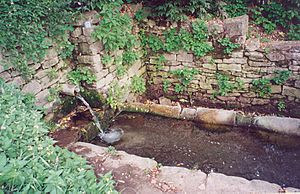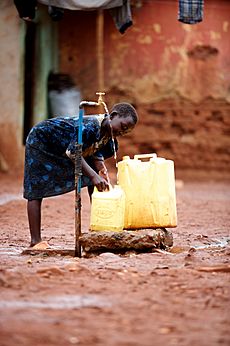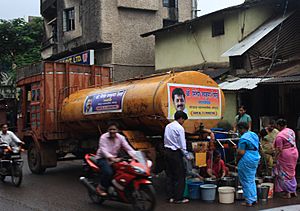Water supply facts for kids

Water supply is how we get water to homes, businesses, and other places. It's usually provided by organizations, companies, or even individuals. This often happens through a system of pumps and pipes. Water for farming (called Irrigation) is a different topic.
Getting Clean Water Around the World

In 2010, most people worldwide (about 5.9 billion) had access to clean water. This water came either directly to their homes through pipes or from improved sources. These improved sources include public standpipes, water kiosks, natural springs, and protected wells.
However, about 900 million people still didn't have access to these improved water sources. They had to get their water from unprotected wells, springs, canals, lakes, or rivers.
Having a clean water supply is super important for everyone's health. Water that isn't clean, especially if it has waste in it, can cause serious illnesses. If water systems are destroyed after big events like earthquakes or wars, there's a high risk of diseases spreading. Many of these diseases can be very dangerous.
How Water Systems Work
Water supply systems get water from different places. These include water found underground in aquifers, surface water from lakes and rivers, and even the sea through a process called desalination.
Before water reaches you, it goes through several steps to make it safe. This usually includes purifying it and adding chlorine to kill germs. Sometimes, fluoridation is also added.
After treatment, the clean water either flows by gravity or is pumped to large storage places called reservoirs. These can be tall water towers or big tanks on the ground. Once water is used, it becomes wastewater. This wastewater usually goes into a sewer system. It then travels to a sewage treatment plant to be cleaned. After cleaning, it can be released into a river, lake, or the sea. Sometimes, it's even reused for things like watering plants or for industrial uses.
How Much Water We Use
In the United States, a typical family home uses about 138 US gallons (522 liters) of water each day. This was estimated in 2016. That's about 58.6 US gallons (222 liters) per person per day.
People use water for many things at home. The most common uses are for toilets, showers, taps (faucets), washing machines, and dishwashers. Water can also be lost through leaks.
How Good is the Water Service?

Many people, especially in developing countries, don't always get good water service. About 80% of the world's population lives in these areas. The quality of water service depends on a few things: how often the water is available, how clean the water is, how strong the water pressure is, and how well water providers respond to problems.
Water Available All the Time
In many developed countries, water is always available, 24/7. But in many developing countries, this isn't the case. Sometimes, water is only available for a few hours a day or just a few days a week. It's thought that about half the people in developing countries get water only some of the time.
Water Pressure

Water pressure can be different in various parts of a water system. The main pipes under the street might have very high pressure. A pressure reducer is often used where water enters a building to lower the pressure.
If a water system isn't managed well, the pressure can be too low. This means only a tiny trickle of water comes out. Or, the pressure can be too high, which can damage pipes and waste water.
In cities, water pressure is usually kept steady in a few ways. It can be done with a pressurized water tank for the area. Or, water can be pumped up into a water tower, and gravity helps keep the pressure constant. Sometimes, pumps at the water treatment plant and other pumping stations are used to maintain pressure.
Images for kids
See also
 In Spanish: Abastecimiento hídrico para niños
In Spanish: Abastecimiento hídrico para niños







